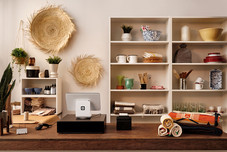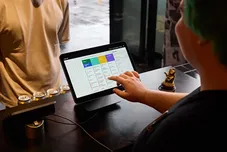Table of contents
Business is a competitive game. To achieve long-term success, you’ll need to be measurably better than your competitors. You’ll need to find the holy grail of modern commerce: your competitive advantage.
A competitive advantage is incredibly desirable; a thing that all organisations hope to find. But, there are also somewhat less encouraging qualities – competitive advantage can be difficult to quantify, and for some businesses, it may be imaginary.
What is a competitive advantage, why is it important and how can you identify yours? These are just a few of the questions that we will answer below.
What is a competitive advantage?
To start, let’s look at the competitive advantage definition.
Competitive advantage is a term that describes all the factors that might allow a business to produce goods and services more efficiently, cost-effectively, or of higher quality, which leads to that business generating more sales at a higher margin than its competitors.
These factors can touch every aspect of a business’s operations. They could be found in production techniques, cost structures, marketing and branding, customer service, intellectual property or a highly tuned distribution network – whatever helps the organisation outperform its rivals.
Amongst an endless list of potential competitive advantages, the following two forms are most common:
- Cost: Beating your rivals on price.
- Differentiation: Separating yourself from the competition.
While this all might sound simple enough, in theory, it can be incredibly difficult in practice. Everyone within your business vertical will be attempting to gain a competitive advantage over everyone else, so creating and maintaining such an advantage is a tall order.
10 types of competitive advantage
What forms does a competitive advantage take in the real world? Here are 10 of the most common:
1. Cost advantage:
Producing and selling your goods/services for less than your competitors is the simplest and most common form of competitive advantage.
2. Differentiation advantage:
This is the process of making your product or service different to that offered by your competitors, in a way that customers value.
3. Technology advantage:
Technology can take care of the busy work, leaving you free to focus on the high-value stuff (e.g. using marketing automation tech instead of manual processes.)
4. Innovation advantage:
If you offer something new to your customers, or innovate within your company in order to create a better offering, you’ll get a head start on your competition.
5. Efficiency advantage:
Efficiency in production, efficiency in delivery; if you do things faster than your competition, you can gain an advantage. Efficiency also goes hand-in-hand with cost management.
6. Usability advantage:
How simple and intuitive is your product compared to that of a competitor? Technology is one space where usability can represent a big competitive advantage.
7. Customer experience advantage:
Put yourself in the shoes of your customer and compare the experience to that offered by a competitor. For example: do you provide multiple payment options, or do you ask for payment in a specific form?
8. Personalisation advantage:
Can you tweak your product to better suit the needs or wants of each customer? If you can, you could enjoy a personalisation advantage.
9. Sales channel advantage:
How many channels do you operate on? An omnichannel business that sells its products through both an online store and a retail shopfront will have an advantage over one that operates exclusively through a brick and mortar store.
10. Scale or variety advantage:
Can you sell items in large quantities and offer a discount in doing so? Can you be your industry’s version of a supermarket, offering an endless variety of products?
In reality, the list of possible competitive advantages is limited only by your imagination. The more unique that competitive advantage is, the more difficult it can be for a rival to replicate.
Real-world competitive advantage examples
Looking for some competitive advantage inspiration? Let’s take a look at two real-world competitive advantage examples that you might be able to replicate in your own vertical.
IKEA and its economies of scale
When you wander the seemingly endless aisle at IKEA – a subject for another day – and look at the prices, it can be hard to imagine exactly how the world’s most famous furniture and homewares retailer makes money. But while the products are ridiculously cheap, they’re also surprisingly high quality. So how does IKEA do it? It’s all down to efficiency, technology and economies of scale.
IKEA is a brand that spans the globe, but where other retailers focus on regional differences, IKEA offers the same products almost everywhere, allowing them to negotiate lower prices on raw materials and have longer and more efficient production runs. What’s more, every product is designed with shipping in mind – wherever possible, items are made foldable, stackable or otherwise compactable, greatly reducing the cost of transport.
Who Gives a Crap does toilet paper differently
The words ‘toilet paper’ might not scream ‘business opportunity to many, but this Australian business success story is a prime example of how differentiation-based competitive advantage can be found in any and every industry… if you’re creative enough.
Founded in 2012, Who Gives a Crap has committed to donating 50% of its profits to building toilets and sanitation in the developing world, which, along with a focus on sustainability, a unique subscription model. Don’t forget the oh so cute and colourful packaging! Who Gives a Crap has generated $41.5 million of funding from investors.
How to identify your competitive advantage
Where might your competitive advantage lie? With such a variety of competitive advantages possible, and with so many types of businesses searching for such an advantage, this isn’t a question with a single, simple answer.
That said, there are a few questions that you can ask yourself to identify areas of potential opportunity:
-
Do you or your team have a unique set of skills?
-
Do you have professional relationships that your competitors don’t?
-
Do you have access to resources that others don’t?
-
Do you have levels of experience or lived experiences that others don’t?
-
Does your brand set you apart from your competitors?
-
Can you create greater internal efficiency?
By honestly answering these questions, you’ll more than likely identify a few threads to chase. And if you commit to doing better and being better than your rivals, you’ll be a decent chance of finding your own competitive advantage.
And if that competitive advantage lies in e-commerce, Square offers the tools you need to succeed.
![]()











